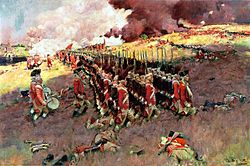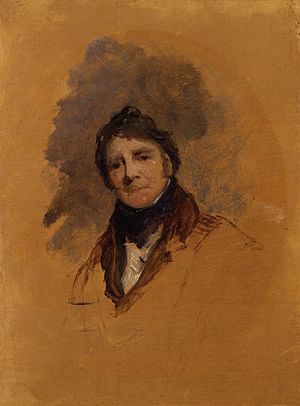65th (2nd Yorkshire, North Riding) Regiment of Foot facts for kids
Quick facts for kids 65th (2nd Yorkshire, North Riding)Regiment of Foot |
|
|---|---|
| Active | 10 December 1756–1 July 1881 |
| Country | |
| Branch | |
| Type | Line infantry |
| Size | One battalion |
| Garrison/HQ | Pontefract Barracks, Yorkshire |
| Nickname(s) | The Royal Tigers Hickety Pips |
| Colors | Facings – White |
| Engagements | Seven Years' War American War of Independence Anglo-French War Napoleonic Wars |
The 65th (2nd Yorkshire, North Riding) Regiment of Foot was a special group of infantry soldiers in the British Army. They were formed in 1756. This group was first known as the 2nd Battalion of the 12th Regiment of Foot. Later, in 1881, they joined with another group, the 84th (York and Lancaster) Regiment of Foot. Together, they became the 1st Battalion of the York and Lancaster Regiment.
Contents
A Look Back: The 65th Regiment's Story
Starting Out: The Seven Years' War
The 65th Regiment was created because the army needed more soldiers. This was due to the start of the Seven Years' War. On August 25, 1756, some existing regiments were told to create a second group of soldiers. The 12th Regiment of Foot was one of these.
The 2nd Battalion of the 12th Regiment of Foot was officially formed on December 10, 1756. It was renamed the 65th Regiment of Foot on April 21, 1758. This new regiment was sent to the West Indies. There, they helped capture French islands like Guadeloupe in 1759 and Martinique in 1762. They also took part in the mission to capture Havana, Cuba in June 1762. In 1764, the regiment returned to England. They then got new soldiers to fill their ranks.
Fighting for Freedom: American War of Independence

In 1768, the regiment sailed to Boston, Massachusetts. They were part of the soldiers stationed there. The 65th Regiment's first fight in the American War of Independence was at the Battle of Bunker Hill in June 1775. Their special Grenadier and Light Companies were part of the attack.
By 1776, the remaining soldiers from the regiment joined other groups. The officers went home to form the regiment again. In 1782, the regiment received a special name linked to a county. It became the 65th (The 2nd Yorkshire, North Riding) Regiment of Foot.
In 1788, the Anglo-French War began. The regiment was sent to the strong fort at Gibraltar in 1782. After that, they went to Canada in 1784 and to Nova Scotia in 1791. In 1793, the regiment sailed back to the West Indies. They took part in attacks on Santo Domingo in September 1794, Martinique in February 1794, and Saint Lucia in April 1794.
Across the World: Napoleonic Wars
The regiment traveled to South Africa in 1800. From there, they went to Ceylon. They were involved in the Kandian War in 1802. In May 1803, they moved to India. They fought in the Second Anglo-Maratha War later that year.
In December 1810, the regiment was sent to the island of Mauritius. They helped capture the island. In 1811, they returned to India. They briefly fought against Oman Coast Pirates in the Persian Gulf in 1819. They also helped with many small uprisings and wars in India. The regiment finally returned to England in August 1822.
Victorian Adventures: Later Years
In 1829, the regiment went back to the West Indies. Then, they continued to Guiana in South America. After that, they returned to Canada. They helped stop the rebellions of 1837 and 1838 before coming home in 1841.
Most of the regiment left Woolwich on a ship called "Java" for New South Wales on May 18, 1846. The regiment fought in the First Taranaki War from 1860 to 1861. They also fought in the Waikato campaign from 1863 to 1864. During this time, Colour-sergeant Edward McKenna and Lance Corporal John Ryan earned their Victoria Crosses at Camerontown.
The regiment returned home in October 1865. They became known as the "Royal Tigers" in England. The Māori called them the "Hickety Pips." This was because of how they said the number 65. The regiment returned to England in 1866. Then, they went to Ireland in 1867 to help stop the Fenians.
On January 11, 1871, they left Queenstown on a ship called "Serapis" for India. The regiment was first based in Agra. People in the House of Commons worried because many of the 919 soldiers in India were under 20. The Secretary of State for War promised to fix this problem. The regiment moved to Lucknow in January 1874. They went to Danapore in November 1877 and to Morar in October 1880.
In the 1870s, the army made changes called the Cardwell Reforms. Single-battalion regiments were linked together. They would share a main base and a recruiting area in the United Kingdom. The 65th Regiment was linked with the 84th (York and Lancaster) Regiment of Foot. They were assigned to district no. 7 at Pontefract Barracks in Yorkshire.
On July 1, 1881, new changes called the Childers Reforms took effect. The 65th Regiment joined with the 84th (York and Lancaster) Regiment of Foot. They formed the York and Lancaster Regiment. The 65th Foot became the 1st Battalion. The 84th Foot became the 2nd Battalion.
Special Awards: Battle Honours
The regiment received special awards called battle honours. These were shown on their regimental flags. They included:
- The Royal Tiger badge with "India" written above it
- Arabia (this award was only given to this regiment)
- New Zealand 1860–61
In 1909, the group that followed them, the York and Lancaster Regiment, received more honours. These were Guadeloupe 1759 and Martinique 1794. They were given for the great service of the 65th Foot.
Brave Soldiers: Victoria Crosses
The Victoria Cross is a very special award for bravery. It was given to these men from the regiment:
- Colour Sergeant Edward McKenna for his actions in the New Zealand Wars (September 7, 1863)
- Private John Ryan for his actions in the New Zealand Wars (September 7, 1863)
See also
- John Orrok



